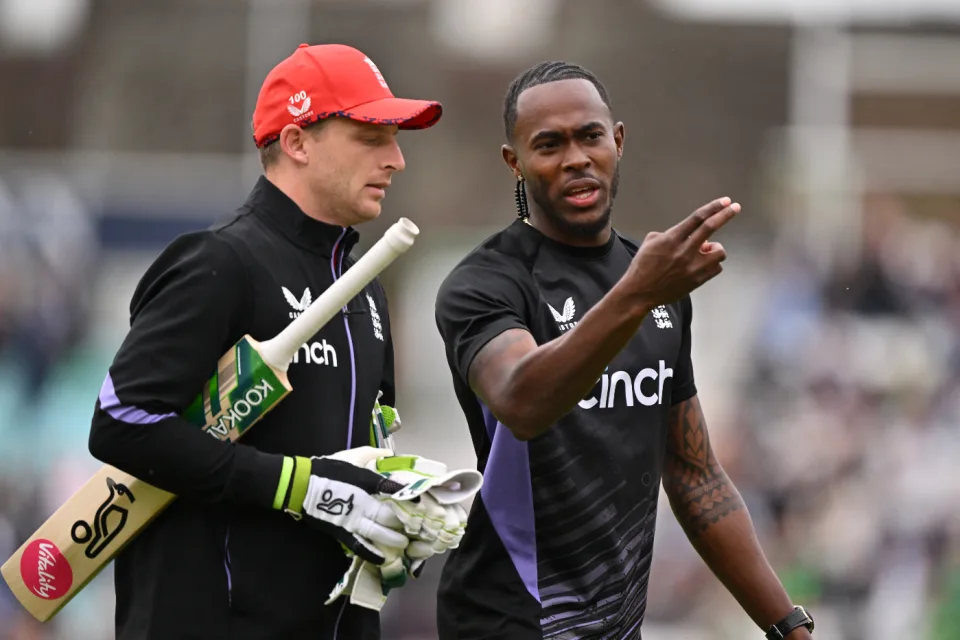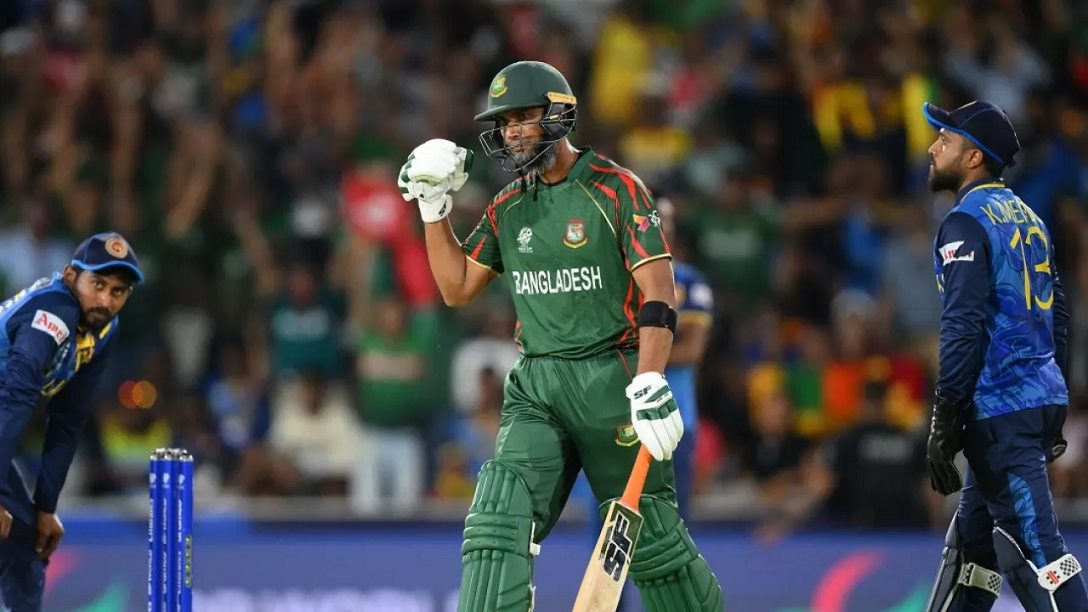Sports
Livingstone 95*, bowlers help England level series in rain-shortened contest

Liam Livingstone’s 95 not out rescued England and set up a series-squaring victory over New Zealand at the Ageas Bowl. His highest ODI score enabled England to set New Zealand 227 to win in a match reduced to 34 overs a side by rain. And despite Daryl Mitchell’s 57, the visitors fell a long way short after a lower-order implosion.
Trent Boult marked his return to New Zealand colours by taking three early wickets in eight balls in his 100th ODI to leave England 8 for 3 in helpful bowling conditions. And by the time Livingstone walked out at No. 7, they had further slipped to 55 for 5 and were facing a fourth consecutive white-ball defeat.
But in partnerships with Moeen Ali and Sam Curran – worth 48 and 112, respectively – Livingstone dragged England up to a competitive total. He started steadily before isolating Tim Southee as the weak link in New Zealand’s attack: Livingstone carted him for six boundaries in 17 balls, and the only surprise was that he could not jump from 91 to three figures off the final two.
Despite his patchy form this summer, Livingstone’s all-round ability and superb IPL record means there has never been any real doubt of his spot in England’s World Cup squad. With two contrasting half-centuries in three days, he has emphatically proved why. This was his longest innings in international cricket, and his highest in a win.
New Zealand lost Finn Allen to the second ball of their chase, castled by David Willey, but looked on course at 111 for 3, with Mitchell in dominant mood. But Reece Topley took three wickets in eight balls in his second spell to finish with 3 for 27, as New Zealand imploded, losing their last seven wickets for 36.
Much before that, Boult, playing international cricket for the first time since last year’s T20 World Cup, did the early damage for England. His New Zealand career has been on hold since late last year after he negotiated a release from his central contract in order to maximise his availability for franchise leagues around the world.
But New Zealand were always likely to welcome him back ahead of next month’s World Cup, and his new-ball spell demonstrated why. Boult struck with his seventh ball, as Jonny Bairstow’s leading edge spooned up towards cover where Mitchell Santner took a spectacular catch, nailing the timing of his leap. Joe Root lasted two balls, smashed on the knee roll by an inswinger, and Ben Stokes gave Boult the charge only to loft to mid-off.
In the absence of Jason Roy (back spasm) and Dawid Malan (paternity leave), Harry Brook was again given the opportunity to open the batting, but he fell immediately after a shortened powerplay. Brook looked to swing Matt Henry over the infield, but his leading edge looped up to the back-pedalling mid-off fielder.
Jos Buttler then led the counterpunch, flaying Boult down the ground for three boundaries in four balls, but fell for 30 off 25 when he chopped Santner’s drag-down onto his own stumps. As with Bairstow and Brook, Buttler’s dismissal hinted at a slowish surface, with several balls sticking in the pitch.
When Livingstone walked out at No. 7 to join Moeen, England had more than 20 overs left to bat. The pair added 48 in 50 balls, starting watchfully before occasionally freeing their arms when New Zealand offered width. Moeen fell for 33 to a brilliant diving catch at point by Glenn Phillips, at which point Livingstone decided it was time to shift gears.
Livingstone targeted Southee, hitting 17 runs off an over – including three boundaries in four balls; by the time he brought up a 47-ball half-century, his second in three days, he had already played his longest innings for England. At the far end, Curran, playing his first game since the Hundred final, belted both left-arm spinners – Santner and Rachin Ravindra – for sixes.
The pair brought up a 100-run partnership at the end of the 32nd over when Livingstone swiped Henry’s slower ball into the stands for his first six. Curran fell shovelling Southee to short third, and after Mitchell trod on the boundary toblerone while attempting a catch off Willey at long-off, Livingstone could only heave the final two balls for a brace of twos.
Allen, who will not feature in the provisional World Cup squad that New Zealand name tomorrow, survived an lbw review off the first ball of the chase but was castled on the second by Willey, even as Gus Atkinson bowled a bright first spell to keep England ahead of the game. He had Devon Conway caught behind, before Will Young was lazily run-out as Willey pounced at mid-off.
Mitchell kept New Zealand ticking, adding 56 with Tom Latham, but Topley’s second spell changed the game. Latham chased a wide one before Phillips fell to a stunning caught-and-bowled, and Ravindra edged his second ball to slip. From 123 for 6, it was Mitchell or bust.
Having hoisted Moeen over long-off for six, Mitchell miscued a full toss to mid-off to give Moeen his 100th ODI wicket; he soon had his 101st too, as Santner sliced to point. Willey mopped up the tail to finish with three wickets of his own, to leave England basking in the early-evening sunshine.
England 226 for 7 (Liam Livingstone 95*, Curran 42, Boult 3-37) beat New Zealand 147 (Daryl Mitchell 57, Topley 3-27, Willey 3-34) by 79 runs
Sports
England face Australia in the battle of champions

The first truly heavyweight clash of this expanded T20 World Cup format comes freighted with both history and subplots. A rematch of the 2010 World T20 final at Kensington Oval, the match pits Jos Buttler’s defending champions – who are aiming to become the first team to retain the trophy – against the Australian winning machine, victors at the 2021 edition and current world title-holders in Test and ODI cricket. And that’s before you throw in the Ashes for afters.
Already there is added pressure on England, after the rain in Bridgetown led to a share of the points in their opener against Scotland (and that having conceded 90 runs from 10 overs without taking a wicket in a tepid bowling display). Lose to their oldest rivals and it will leave their Super 8 prospects open to being waylaid by the perils of net run-rate calculations, or worse.
The Scotland match was the third abandonment in five suffered by England, after a rain-affected home series against Pakistan, which has clearly hampered their readiness for this campaign after almost six months without playing T20 together. It does not take much for a side to click in this format – and England looked in decent shape when they did get on the field against Pakistan – but Buttler will be anxious for things to go their way on Saturday, if only to avoid further questions referencing the team’s disastrous ODI World Cup defence last year.
Australia, under the laidback leadership of Mitchell Marsh would love nothing more than to add to the English sense of jeopardy – having helped bundle them out of the tournament in India on the way to taking the crown. Their head to head record is less impressive in T20 however, with England having won six of the last seven completed encounters, as well as that 2010 final.
Despite a wobble with the bat, Australia avoided mishap against Oman earlier in the week, the experience of David Warner and Marcus Stoinis shining through in difficult batting conditions. Surfaces in the Caribbean – not to mention those games staged in the USA – have already had teams scratching their heads; rather than the “slug-fest” England had prepared for, following a high-scoring tour of the Caribbean in December, it looks as if boxing smart may be the way to go.
Speaking of Warner, this could be the last time he faces up against England in national colours – and another match-winning contribution would likely reduce the chances of them meeting again in the knockouts. On the other side of the card is Jofra Archer, fresh from an emotional maiden outing at Kensington Oval and ready to take on Australia for the first time in any format since 2020. Can Mark Wood fire up England’s campaign, as he did during last summer’s Ashes? Will Pat Cummins be back to harass the old enemy once again? Seconds out, it’s almost time to rumble.
Cummins is set to return after being rested for the Oman game, which saw Mitchell Starc leave the field with cramp. Starc is understood to be fine and could keep his place – which would likely see Nathan Ellis miss out. Marsh is still not fit to bowl, with Australia likely to continue with the allrounder combination of Stoinis and Maxwell to give them cover.
Australia (probable XI): David Warner, Travis Head, Mitchell Marsh (capt), Glenn Maxwell, Marcus Stoinis, Josh Inglis (wk), Tim David, Pat Cummins, Nathan Ellis/Mitchell Starc, Adam Zampa, Josh Hazlewood
The one change England may consider is Reece Topley coming in for Wood, with the expectation that there will be some rotation among the seamers through the course of the tournament.
England (probable XI): Phil Salt, Jos Buttler (capt & wk), Will Jacks, Jonny Bairstow, Harry Brook, Liam Livingstone, Moeen Ali, Chris Jordan, Jofra Archer, Adil Rashid, Reece Topley/Mark Wood
[Cricinfo]
Sports
South Africa up against their bogey team in batter-unfriendly New York

Once is coincidence, twice is a clue, and three times is proof.
To paraphrase Agatha Christie, that is the narrative around South Africa’s meeting with Netherlands at this T20 World Cup.
The Dutch beat South Africa at the 2022 tournament and ended their semi-final hopes in a match where South Africa appeared to be sleep walking, and then beat them again at the 2023 ODI World Cup, where they exposed South Africa’s vulnerability in the chase. If they to do the treble, not only will Netherlands take the lead in Group D, but they will offer conclusive evidence of the threat they pose to Full Members, especially South Africa.
Of course, it will take some doing after South Africa’s opening performance against Sri Lanka, where they reduced their opposition to their lowest T20I total and chased it down in fairly straightforward fashion thanks to the most stable middle-order of their white-ball era. In Aiden Markram, Tristan Stubbs, Heinrich Klaasen and David Miller, South Africa have bankers and big-hitters and, for this match, they also have the advantage of experience. They’ve already played at Eisenhower Park, and have first-hand knowledge that run-scoring doesn’t come easily;Klassen said they are prepared to use their “cricket brains” and play “smarter cricket”.
But the conditions could be good news for Netherlands, who are not naturally a line-up of big hitters and build their innings on a foundation of turning ones into twos. In other words, they tend to take a slightly more conservative approach to batting, which may work well here, but they’ll be wary of the uneven bounce of the surface and will have to come up with plans to counterattack especially against South Africa’s seamers. Their own bowlers were exemplary in Dallas and will look to build on that performance against a line-up that will likely be more proactive than Nepal’s, but who they have managed to keep quiet not once, but twice in the past. Third time’s the charm, they say.
Anrich Nortje’s stunning return to form against Sri Lanka means South Africa may not have to tinker with the bowling combination, and Gerald Coetzee and Tabraiz Shamsi may have to wait their turns to get a game. The batting line-up should be unchanged, with no space for Ryan Rickelton yet.
South Africa: Quinton de Kock (wk), Reeza Hendricks, Aiden Markam, Tristan Stubbs, Heinrich Klaasen (wk), David Miller, Marco Jansen, Keshav Maharaj, Kagiso Rabada, Ottneil Baartman, Anrich Nortje
Conditions in New York may tempt Netherlands to include an extra seamer and they have Kyle Klein in their squad. But it could come at the expense of a shortened batting line-up and they may not want to risk that.
Netherlands: Michael Levitt, Max O’Dowd, Vikramjit Singh, Sybrand Engelbrecht, Scott Edwards (capt, wk), Bas de Leede, Teja Nidamanuru, Logan van Beek, Tim Pringle, Paul van Meekeren, Vivian Kingma
[Cricinfo]
Latest News
Mustafizur, Rishad, Hridoy dazzle in Bangladesh’s tight two-wicket win over Sri Lanka

Nuwan Thushara’s last over brought Sri Lanka screaming back into the match,as he first bowled Rishad Hossain, and then nailed Taskin Ahmed in front of the stumps with a pinpoint swinging yorker. This left Bangladesh eight wickets down, with 12 runs still to get.
However, the experienced Mahmudullah was at the crease for Bangladesh, and despite some further nervy moments, pushed Bangladesh across the line off the last ball of the 19th over.
But this was a match chiefly decided by Bangladesh’s own outstanding bowling. Mustafizur Rahman was the best among them, using shorter lengths and his cutters efficiently, to claim figures of 3 for 17. Rishad Hossain’s three-for through the middle overs also kept Sri Lanka quiet.
Mustafizur was instrumental in Sri Lanka’s downward spiral through the middle overs, which culminated in a crash-and-burn end. Ultimately, their inability to find boundaries, or even rotate strike against good Bangladesh bowling resulted in their downfall. A score of 125 for 9 always seemed poor on a decent pitch, even if their bowlers made a match of it in the end.
Brief scores:
Bangladesh 125 for 8 in 19 overs (Towhid Hridoy 40, Litton Das 36; Dhanajaya de Silva 1-11, Nuwan Thushara 4-18, Wanidu Hasaranga 2-32, Matheesha Pathirana 1-27) beat Sri Lanka124 for 9 in 20 overs (Pathum Nissanka 47, Dhananjaya de Silva 21; Tanzim Hasan Sakib 1-24, Taskin Ahmed 2-25, Mustafizur Rahman 3-17, Rishad Hossain 3-22) by two wickets
[Cricinfo]






















